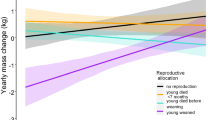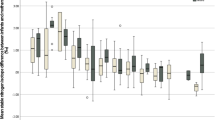Abstract
The Trivers-Willard hypothesis of sex-biased maternal investment in response to fluctuations in resource availability has provided a theoretical foundation for research on maternal investment for more than two decades. Their hypothesis holds that mothers in poor condition as a result of poor resource availability should bias parental investment towards offspring with the highest probability of reproducing. In the polygynous mating system of mammals where males compete for breeding access to females, the hypothesis predicts investment favoring females. Although data from many systems have supported this hypothesis, other systems do not follow the predicted patterns and have resulted in various alternative hypotheses. The present research was designed to test whether differences in body condition of young reared by nutritionally stressed dams relative to young reared by unstressed dams were maintained into adulthood, one of the fundamental assumptions underlying the Trivers-Willard hypothesis. Post-weaning growth in eastern woodrats (Neotoma floridana) and northern grasshopper mice (Onychomys leucogaster) was examined relative to maternal nutritional plane. Individuals from undernourished dams were lighter than their unrestricted counterparts at weaning but no difference was evident by the time they had reached adult size. Failure to maintain body condition differences into adulthood violates one of the assumptions essential for application of the Trivers-Willard hypothesis of maternal investment patterns. Although the Trivers-Willard model proposed that natural selection favors differential investment in the sexes over the entire course of parental investment, evidence from this and other studies suggests that the Trivers-Willard hypothesis might not be appropriate to address maternal investment questions in postnatally malnourished dams, but instead should be restricted to systems concerned with prenatal maternal condition or resource availability.
Similar content being viewed by others
Author information
Authors and Affiliations
Additional information
Received: 22 February 1995/Accepted after revision: 30 December 1995
Rights and permissions
About this article
Cite this article
Sikes, R. Effects of maternal nutrition on post-weaning growth in two North American rodents. Behav Ecol Sociobiol 38, 303–310 (1996). https://doi.org/10.1007/s002650050246
Issue Date:
DOI: https://doi.org/10.1007/s002650050246




